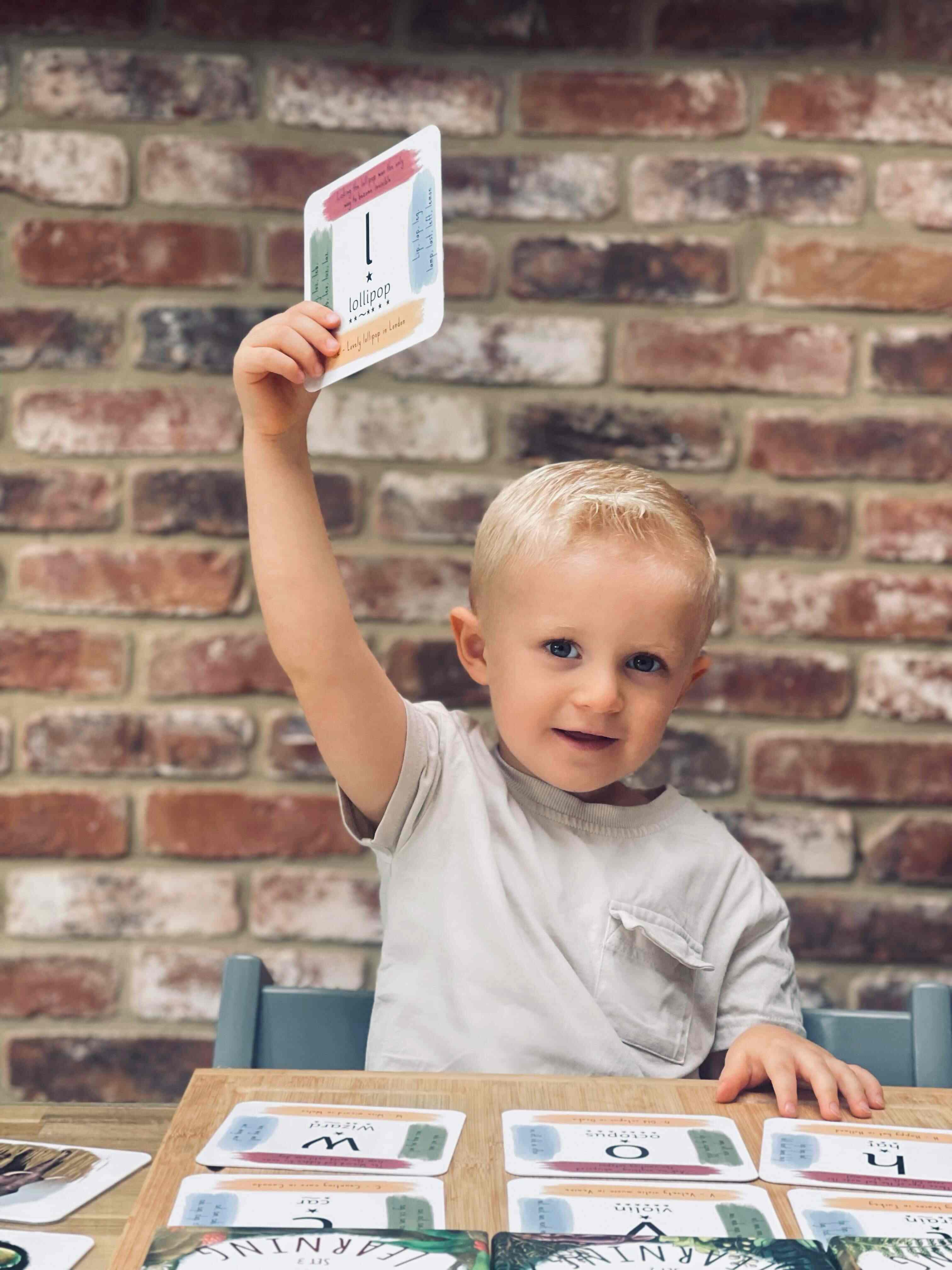Learn more about our Phonics & Storytelling Cards
Expertly designed, award-winning learning cards to support phonics, reading and writing with a storytelling element to develop language skills alongside the reading and writing journey.
Suitable from Age 3 for pre-reading skills up to age 10 for independent writing.
How Do The Different Coloured Sections Work?
 Practise ‘Real’ Words
Practise ‘Real’ Words
The blue section is a list of suggested practise words for the phonics sound represented. These are real words designed to be readable early on and to be used in games and activities. Use the practise words for decoding (sounding out) and aim for your child to be able to read the practise words before writing them.
Here are some fun ways to use these words:
-
Word Treasure Hunt: Write the words as a list and then onto individual pieces of paper which are then hidden. Your reader searches and ticks them off as they find them!
-
Gloop writing: Messy but fun...mix up a shallow tray of corn flour and water and write the words one at a time in the gloop. Your reader has to try to read the word before the gallop reforms. Then switch tasks!

Practise ‘Nonsense’ Words
The green section is a list of nonsense (pseudo) words. These words are designed to support the decoding (sounding out) process. Part of the phonics process involves being able to read words that do not exist. This skill shows us that learners are building a phonic code in their memory bank and can apply it without using the memory of the full word.
Here are some fun ways to use these words:
-
Word Building: Write all the different graphemes ( letters or letter combinations) onto small squares of paper and challenge your reader to build the nonsense words on the cards or from a list you have written.
-
Word Sort: Have all the practise words from one card ( green and blue) written on slips of paper and ask your reader to sort them into real or nonsense words by reading each one.

Capital Letters & Alliteration
On the back of each learning card in set one*, you will find a little phrase of alliteration and a demonstration of how and when to use a capital letter. Capital letters are used at the start of a new sentence and at the start of a proper noun. It is really important for children to recognise capital letters as they will be cropping up in the books they are reading. The alliteration rhyme is a fun way to make each sound memorable, we call these 'mind hooks'. Anything that helps to solidify the phonemes and graphemes in our reader’s memory is going to be a huge help. * In sets 2 &3 the yellow section contains a mind hook phrase.
Alliteration is the head rhyme heard when a string of words have the same starting sound which does not have to be spelt the same. eg. Tiny, tired tadpoles... seeing seagulls in the City.
Excellent Elephant called Eric.

Magical Story and Conversation Starters
On the back of each learning card, you will find something a bit enchanting and magical to talk about…
Each card gives either a story starter for you and your child to then build upon or a statement to discuss, these cards double up as storytelling cards! The words are linked to the illustration on the front to aid the imaginative process. Talking about stories and using the imagination can have huge benefits to language development which feeds straight into reading and writing. Stories and imaginative thought can positively shape children’s perception of the world and exploring things that are unknown to them can lead to greater acceptance of people’s differences.
The road was lit by the first rays of the sunrise and this car was choosing its own path...
What are the stars and wiggles for?
In phonics, we use 'sound buttons' to clarify how different letters sit together to make one sound. This is not only useful for children but beneficial for the adults using our cards to support children.
Sound stars and wiggles
You will see the star sitting under single letter sounds
( graphemes) such as: d /c

The wiggle sits nicely under the digraphs and trigraphs, these are the sounds that contain more than one letter such as: igh / qu

The shooting star sits above a split-vowel digraph ( sometimes known as 'magic e'). When the vowels are split by a consonant and the word ends in an e, the first vowel sounds like its letter name.

Which sounds are included in each set?
There are 3 sets of cards which make up the full collection. All 44 phonemes in the English language
(sounds you hear) are included and represented by 78 Graphemes ( letter/letter combinations you see).
Our Set One phonics sounds are introduced in this order to allow for early decoding ( reading) opportunities: s,a,t,p,i,n,m,d,g,o,c,k,e,u,r,h,b,f,l,j,v,w,x,y,z,qu
Set one contains single letter sounds to allow for our capital letter element included in set one. Most phonic programmes introduce some digraphs slightly earlier on, our cards are not a stand alone programme but, across the three sets of learning cards, do cover all sounds in all major worldwide phonic programmes and are designed to be complimentary.
Set Two sounds are introduced in this order:
ch,ck,ll,ff,ss,zz,th,sh,ng,nk,ai,ee,or,igh,oa,oo,oo,ar,ur,er, ow,ea,oi,ear,air,ure
Set Three sounds are introduced in this order:
ay,ou,ow,ie,oy,ir,ue,aw,wh,ph,ew,oe,au,ey,a-e,e-e,i-e,o-e,
u-e,ire,are,gu,kn,g(soft),c(soft),tion.


